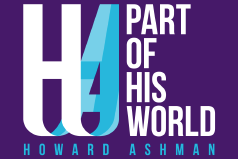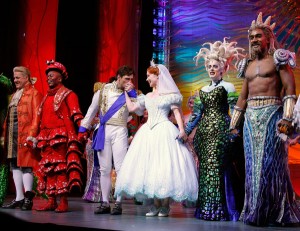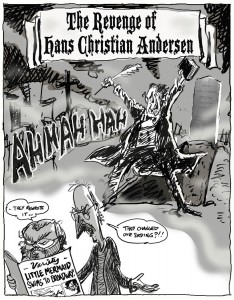John Musker Question Countdown #4
Question #4 What did you think of the stage adaptations of Aladdin and Little Mermaid? Did you get to have any input during the creative process of either show?
Ron Clements and I had almost no input to either the Little Mermaid or Aladdin stage productions. I am not sure exactly why. Roger Allers and Irene Mecchi collaborated on the book for the stage musical of Lion King. Whether the people producing the plays didn’t like our writing (or us?) or wanted a free rein to reinvent the material, or thought we were not versed in writing for the theatre, or some combination of all those and maybe some other reasons, we were not approached. We would like to have been more involved. Both Ron and I like live theatre and it would have been a fun challenge to try and rework the material for a different medium.
In the early going on Little Mermaid’s stage adaptation we were invited to a lunch with Matthew Bourne and his designer. I think this was around 2001 but I am not sure. Matthew had been enlisted to develop his vision for Mermaid. I thought the choice of Matthew was inspired and I was a big fan of his work. I have seen his all-male Swan Lake, Carman (his reimagining of the opera Carmen as literally a “car man,” a tee shirted auto mechanic in a noir-y universe) and his Cinderella with its British wartime Blitz backdrop. I loved all these very visual and filmic dance pieces. It seemed from our discussion that he envisioned something fairly dark for Mermaid. We heard a few little things second-hand about him developing choreography for it and trying to find a movement style that suggested “underwater” but at some point we heard Matthew was no longer developing the show. Whether his vision was too dark to reconcile with Disney, or he had other commitments, or he or Disney lost interest, I do not know, but I was sorry to hear he was no longer working on it.
Flash forward to August or so of 2007. The show had been developed by an entirely different team of writer, director and designer. It was being tried out on the road in Denver and an invitation was extended to Ron and me to come see it. So off we went. We had dinner with the gifted director Francesca Zambello, who had staged several distinguished and powerful operas. She also had been commissioned by the Disney parks to develop a stage version of Aladdin. I had seen her staging of Aladdin at Disneyland/ California Adventure done with Anne Hamburger and really enjoyed its 45 minute version of the story and its invention and humor and lightness.
As for the production of Little Mermaid that we saw in Denver, I thought Sierra Boggess, who played Ariel and Sherie Rene Scott as Ursula were both terrific. Sierra sang beautifully (and looked beautiful) and did a wonderful job of projecting Ariel’s youthful enthusiasm and made her yearning seem genuine. Sherie was campy and vampy and funny and grandly diva-esque. There were some new songs by Alan that I liked but the standout songs still seemed to be the originals from the movie.
But I gathered that we were there in part because they felt some things were not working as well as they should. Upon seeing it, I did think there were a number of difficulties. Ron and I, as we have developed animated films, have generally tried to exploit the animation medium while telling the story. We try and do them in a way that minimizes things that are too “live action” in their approach, and to emphasize some of the fantastic elements that animation is so good at (in film this has become increasingly difficult in this CG and Digital age where even live action can seemingly do almost anything.) On a basic level, for example, it would be difficult to do a live action film of Little Mermaid because, among other things, characters speaking (and singing!) underwater would seem odd or disturbing, I think. We have a villainess who moves like both a woman and an octopus. We have a tiny little crab who has an overstuffed grandness about him that completely belies his diminutive stature. All of these elements are difficult to translate to the stage. The size relationship of Sebastian to Ariel and Triton (and a comic part of their dynamic) becomes very problematic once a life-size actor dresses as Sebastian.
Lion King (and Beauty to a lesser extent) had their own enormous challenges of translation. Clearly, Lion King, with Julie Taymor’s puppetry and stylization, was a spectacle that was a reinvention of the movie that worked on its own terms, while honoring the emotional highs of the film and the power of its story, characters and music, both the songs and the underscore. It has recently passed Phantom for the biggest box office ever and deservedly so. If you’ve seen the film, you can see the play and love it for its faithfulness while being highly inventive. If you haven’t seen the movie you can see the play and still love its story, characters, music, and beautiful and engaging spectacle.
Little Mermaid did not achieve the incredible success of reinvention while being faithful to its source as Lion King, despite the fact that the people involved are all brilliant talents. One of the most essential questions in staging Little Mermaid was how do you suggest the illusion of swimming, since much of the story takes place in a world where characters don’t simply move right and left, but can soar and dive as well? They ultimately addressed this issue by taking the approach, “No water, no wires.” But their solution to creating the illusion of swimming, the use of roller skates tucked behind costumes, seemed to me to be a mixed bag at best. It gave the merpeople speed, and a slightly non-human locomotion. But they had none of the lyricism of swimming where you can move on any axis. They were confined to a very narrow and earthbound back and forth movement on one plane. I haven’t seen Spiderman on Broadway with its wire work, but I felt wires might have worked better to suggest some of the freedom of movement that we had in the film. Perhaps there was another solution to this problem of “swimming”, but the elegance of movement that we had in the film was gone in the stage version. In the movie, as Ariel sings Part of Your World, she swam about her grotto and interacted with different props and sections of the grotto itself. I was looking forward to seeing this dramatized on stage. But in the play she was sadly immobile, singing the entire number in one place. She was unable, therefore, to physically express her exuberance for the human world. It undermined the emotional message.
We had other issues as well. It is ironic of course that the play changed the ending of our film, after we had the temerity to change the ending of Hans Christian Andersen’s classic fairy tale (our “Sorry, Hans!” or maybe more apropos, “Look, Ma! No Hans! ending”). For the annual caricature show at Disney, I did the drawing I am including with this post, where I riffed on this irony that Ron and I are now victims of… “The Revenge of Hans Christian Andersen.”
In the staging of Mermaid that we saw in Denver, they had reworked our film’s ending and although I don’t remember clearly the ending we saw staged, I believe the play’s book had been rewritten to try and make Ariel more the master of her own fate. She had a shell with her voice that she shattered that defeated Ursula and as I recall, , the king didn’t give her her legs.
I believe they had already gotten a very strong reaction from the audiences that they missed more of the story from the movie, particularly the ending. Ron and I were invited to give notes on what we had seen, but there was an opening in New York looming (also a stagehand strike that delayed things a bit) so aside from anything else, there was a definite limit as to what could be done.
I did write several pages of notes. I knew they couldn’t reinvent how they handled the swimming, but I hoped they could rework the mermaid costumes that felt awkward, unflattering and truncated to me. I didn’t like Flotsam and Jetsam being played as over the top and campy as they were. I felt the menace Ursula had in the film made her more imposing. I could understand the need for as much fun comedy as they could find, but even for me this was too much.
But my principal story objections had to do with the Triton/Ariel relationship. I feel that Howard and Alan’s brilliant score of songs, certainly is one of the principal reasons for the movie’s ongoing popularity. But one of the other reasons, I believe, is the emotion of the father-daughter story, the overprotective father who limits and punishes his daughter for her independence, but who finally recognizes that he has to let her go and changes (unlike Ariel, who really doesn’t have an “arc” in our story. It is Triton and Sebastian who change over the course of the story, not Ariel.) More so than the romance between Ariel and Eric, I think the Triton/Ariel relationship is the key to the deeper emotional involvement of the audience. And I thought this needed more support. Certainly, the ending , where Triton decides to make Ariel human (which they did change for Broadway) was a part of this. Not having this key scene in Denver really left the audience behind.
In both the Denver casting and later in New York, they had an African American actor play Triton. I thought, while the actor himself was capable, on a basic literal level, this “color blind” casting put distance between him and Ariel. Regardless of whatever issue they may have been trying to ameliorate by this, I thought it was wrong to cast Triton as black. He just didn’t seem clearly to be her father. I went further and suggested a new musical number be given to Triton earlier in the play where he would vent his frustration (comically but hopefully poignantly). I thought he could bittersweetly lament that as the King of the Sea he has this immense power over the oceans and the elements, but he’s got no sway over his own headstrong daughter. Our Triton was blustery and less straight. I thought that gave him some warmth to leaven his misanthropy.
In Lion King, they added numbers that created musical links that amplified the emotion. For example, the powerful new He Lives in You number that gave the father/son story a strong song to drive its emotion home, emotion that was there in the film, and in its underscore, but not actually in a song. I thought, however it was done, new song material that would help amplify the emotion of the father/daughter story would have gone a long way to getting a deeper resonance for the play. Both fathers and daughters, as they do when they see the film, could relate emotionally to this issue from their different vantage points.
Our ideas did not materialize in the New York version. Whether they were considered too extreme, or there wasn’t enough time to change things, or they found the suggestions tacky (I suggested that the skaters/fish in Under the Sea have “bubble generators on them they could have made some cool patterns…c’mon, that’s not too theme park-y, is it?). Trite or just bad, I don’t know, either way, they didn’t come to pass.
I understand that currently there is some kind of reworking of Mermaid going on, which Alan feels works “a lot better” in his words. I heard a rumor that the roller skates are gone. I think the people behind these theatrical productions are very smart, very talented, and very hard working. I hope they have found a way to translate our movie in a way that works better for an audience.
Aladdin, which we have seen in two incarnations was a much more pleasant experience.
As I said earlier, Francesca’s staging at Disneyland was a lot of fun. The actor I’ve seen play the Genie there is a riot, and the continual reworking of his material to include references that reflect the headlines of the day is very funny. The musical staging seemed livelier and looser, than the more cumbersome Mermaid one.
Ron and I were invited by Steve Fickinger of Disney Theatrical development to see the production of Aladdin in Seattle. This was more of a courtesy than a request for input (maybe after my last notes, the brief window of input, like the tiger’s mouth in the Cave of Wonders, had closed forever.) Ironically perhaps, Ron and I both thoroughly enjoyed this production of Aladdin, despite the liberties it took with the film. We thought Casey Nicholaw was a great choice as a director, and his energy, sense of entertainment and comedy, really worked well and were very much in keeping with the spirit of the movie. Chad Beguelin, the book writer, found clever ways to work in terrific Ashman/Menken numbers cut or never used in our film because of various story changes and/or characters being eliminated. The actor playing the Genie in this production, James Monroe Iglehart, was African American as Howard had originally intended, and he was fantastic, as was the cast generally.
Our principal hope was that if Aladdin moved on to Broadway or anywhere near Broadway, they would put enough money into its production to make things like the flying carpet ride genuinely thrilling, something that the shoestring Seattle production couldn’t afford.
I hope both Mermaid and Aladdin continue to be developed for the stage regardless if we are involved (and God knows if we ever will be, although I am hoping that my notes both here and in the past are taken as the supportive and constructive suggestions they are meant to be.)
Truly, I would love to have seen Howard’s take on the stage versions of these films. He died before seeing any of these stage productions, including Beauty and the Beast.
Howard passed away even before the films of Beauty or Aladdin were released. Mermaid is the sole Disney animated feature for which he wrote the entire song score that he saw completed. Maybe in the next world, we’ll see Howard’s stage version.


